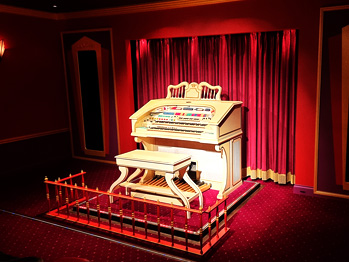Rudolph Wurlitzer is an
American company started in Cincinnati in 1853 by German immigrant
(Franz) Rudolph Wurlitzer.
In the late 1800s, fairs were popular. As crowds grew and mechanical
rides began to appear, there was a need for louder music and the
fairground organ was developed. Eugene DeKleist of North Tonawanda,
New York, was an early builder of such organs (also called "barrel
organs") for use in carousels. Wurlitzer bought an interest in
DeKleist's North Tonawanda Barrel Organ Factory in 1897. In 1909,
Wurlitzer bought the entire operation.
The "Mighty Wurlitzer" theatre organ was introduced in late 1910 after
acquiring Robert Hope-Jones patents and plant. It became Wurlitzer's
most famous product. Wurlitzer theatre organs are installed around the
world in theatres, museums, churches and private residences.
In 1914, Wurlitzer manufactured pianos at the Clark factory in DeKalb,
Illinois.
After the war, Wurlitzer came out with several models using reeds and
electronic amplification. One clarification should be made at this
point, these organs are not actually reed organs in the sense of
Grandma’s old pump organ. The reeds are only used to produce the
vibration necessary to generate a frequency, which is then subject to
electronics. You do not actually hear the sound of the reeds.
In 1959, Wurlitzer introduced
their first electronic organs using master oscillators. Wurlitzer
still continued to manufacture the reed-electric organs until 1964.
Two Wurlitzer inventions also came on the scene. The Side Man, an
automatic rhythm unit was introduced in 1959. This was a separate unit
with its own controls and amplification, and was smaller than a tone
cabinet. Wurlitzer’ other invention was the Ssh-Boom, which provided bass
drum and cymbals sounds when activated by the keys.
In 1964, Wurlitzer gave up vacuum tubes and went all-transistor. Organs
included, for the first time, Spectra-Tone, which was a rotating speaker
system actually built into the console. It was similar, but not identical
sounding to a Leslie speaker. These models also included the Ssh-Boom.
The next significant development was the introduction of the Orbit
synthesizer, a 2 octave keyboard above the two manuals of the organ. The
first model to include this was the 370 spinet. It made its way to all
models. Eventually, a genuine Leslie replaced the Spectra-Tone.
In the mid to late 1970s, Wurlitzer developed models that can be
considered the greatest age of the Wurlitzer electronic organ. The Models
630 and 950 were superlative instruments. They had theatre voicing,
electronic organ sounds, special effects, automatic left hand and pedal,
the Orbit, the Slide and much more. Other smaller versions were also
available.
In 1980, Wurlitzer introduced their so-called “analog-digital” organs.
Although Wurlitzer did not invent the computer organ, they jumped into it
headfirst. These organs used the microprocessor for the wrong reason, that
is, to generate the automatic left hand and pedal; it should have been
used for the tone generator. These organs did not have distinct
differences in stop voicing, and many people did not like the “earth tone”
colors of the stop tablets.
In the 1980s, Wurlitzer started working with Hohner in Germany, and
manufactured the Omni series of organs in competition to the new portable
keyboards that were competing with the organ market.
The Wurlitzer piano and
organ brands and U.S. manufacturing facilities were acquired by the
Baldwin Piano & Organ Co. in 1988. The Baldwin Co., including its
Wurlitzer assets, was subsequently acquired by the Gibson Guitar
Corporation in about 1996.
|










